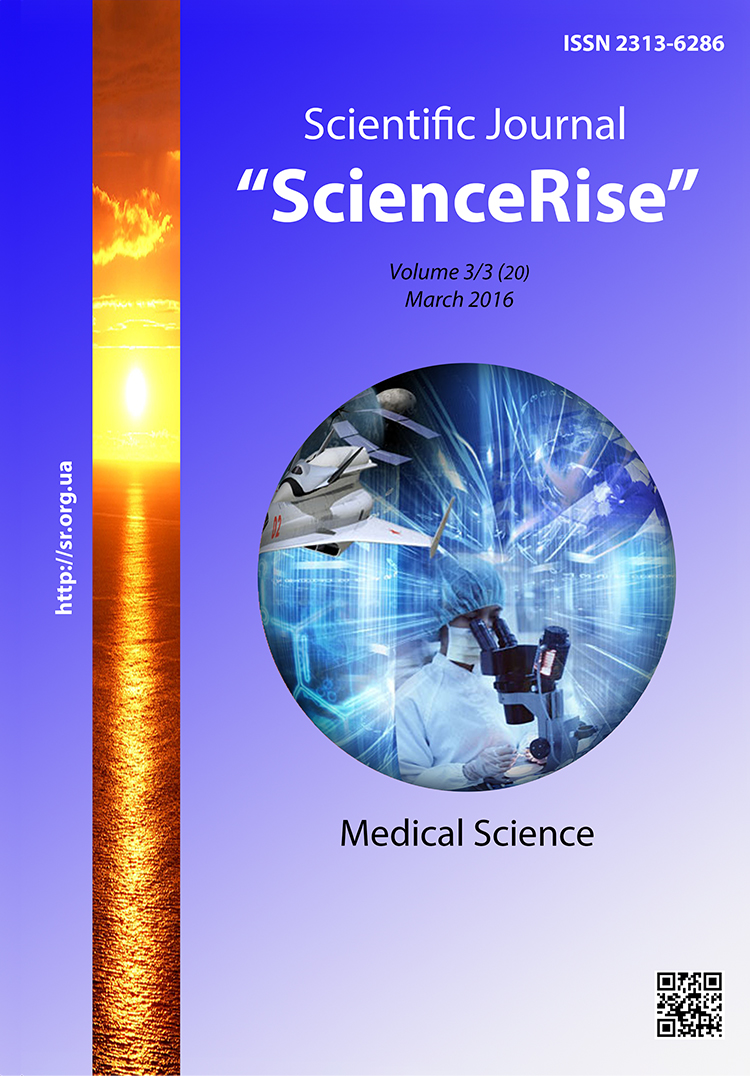Videolaparoscopic surgical interventions in emergency surgery
DOI:
https://doi.org/10.15587/2313-8416.2016.65111Keywords:
videolaparoscopy, appendicitis, acute cholecystitis, acute pancreatitis, acute intestinal obstructionAbstract
Aim: To improve the results of treatment of patients with emergency surgical pathology by the analysis of the use of videolaparoscopic surgical interventions.
Methods: in the period 2012–2014 year in MI “Zaporozhye municipal clinical hospital of emergency” in the first surgical department on the base of subdepartment “General surgery with care for patients” of Zaporozhye state medical university were carried out 791 videolaparoscopic surgical interventions.508 (64,2 %) women, 283 (35,8 %) men. The mean age of patients was 48±2,1.
The most videolaparoscopic operations were carried out at the acute appendicitis– 359 (45,5 %). Laparoscopic cholecystectomy at the acute cholecystitis was carried out in 157 patients (19,9 %). At the acute commissural intestinal obstruction were carried out 8 videolaparoscopic operations – (1 %). Videolaparoscopic drainage of abdominal cavity at the acute pancreatitis was carried out in 79 patients (10 %). At gynecological pathology were carried out 162 videolaparoscopic surgical interventions (20,6 %) and in 26 patients (3,1 %) was done diagnostic videolaparoscopy.
Result: At the acute appendicitis were carried out 359 (45,5 %) videolaparoscopic surgical interventions. There were no complications in postsurgical period. The mean bed-day was 6,8±0,7.
Videolaparoscopy at the acute cholecistitis was carried out in 157 patients (19,9 %). In 17 (10,8 %) was carried out conversion and surgical intervention was continued from laparotory access.
At the commissure intestinal obstruction were carried out 8 surgical interventions (1,0 %). All patients underwent surgery after the short-term pre-surgical preparation. Conversion was carried out in 2 patients (25 %). In 1 (12,5 %) was injured the loop of small intestine and in 1 (12,5 %) took place the total commissure disease in abdominal cavity.
Diagnostic laparoscopy was carried out in 26 patients (3,1 %), in two of them – at the close blunt trauma of the stomach.
Videolaparoscopic drainage of abdominal cavity at the acute pancreatitis was carried out in 79 patients (10 %). In 28 patients (35,4 %) along with drainage of abdominal cavity was carried out the laparoscopic cholecystectomy (concrements in gallbladder).
Conclusions: Videolaparoscopic surgical interventions in emergency surgery allow carry out the more qualitative diagnostics and significantly diminish the risk of postsurgical complications. The minimal surgical trauma allows activate patients in the early postsurgical period, shorten the terms of stay at hospital and improve the life quality.
Elaboration of indications and contraindications to videolaparoscopic surgical intervention in patients with emergency surgical pathology prevents the intrasurgical complications development
References
Matviychuk, B. O., Kvit, A. D. (2014). Rol ta znachennya videolaparoskopii v diagnostychno – likuvalnomu algorytmi hvoryh z atypovym perebigom gostrogo apendicitu [Videolaparoskopiya role and importance in diagnostic – therapeutic algorithm of patients with atypical course of acute appendicitis]. Ukrainckiy jurnal hirurgii [Ukrainian Journal of Surgery], 1 (24), 58–60.
Polymeneas, G., Theodosopoulos, T., Stamatiadis, A., Kourias, E. (2001). A comparative study of postoperative adhesion formation after laparoscopic vs open cholecystectomy. Surg Endosc, 15 (1), 41–43. doi: 10.1007/s004640000269
Grubnik, Yu. V. et. al. (2014). Pokazaniya i effektivnost icpolzovaniya maloinvazivnyh operaciy u bolnyh s zakrytoyi travmoyi bryushnoyi polosti [Indications and efficacy of the use of minimally invasive surgery in patients with closed abdominal trauma]. Harkivska hirurgichna shkola [Kharkiv surgical school], 1 (65), 101–104.
Chemodanov, E. B., Zaevskaya, E. V. (2008). Vybor taktiki hirurgicheskogo lecheniya u bolnyh spaechnoyi boleznyu bryushnoyi polosti [The choice of tactics of surgical treatment in patients with abdominal adhesive disease]. Trudy Krymskogo gosudarstvennogo melicinscogo universiteta [Works of the Crimean State Medical University], 144 (4.1), 262–265.
Nekrasov, A. Yu., Kasumyan, S. A., Pribykin, A. A. et. al. (2009). Laparoscopiya v diagnostike i lechenii ostrogo appendicita [Laparoscopy in the diagnosis and treatment of appendicitis]. Endoskopicheskaya hirurgiya [Endoscopic surgery], 3, 31–34.
Chernov, V. N. et. al. (2014). Lechenie inficirovanyh form ostrogo destruktivnogo pankreatita s ispolzovaniem maloinvazivnyh tehnologiy [Treatment of infected forms of acute destructive pancreatitis using minimally invasive technologies]. Novosti hirurgii [Surgery news], 22 (1), 63–67.
Miringof, A. L., Novikov, V. V., Sukovatyh, B. S. et. al. (2007). Novyi podhod k profilaktike i lecheniyu posleoperacionnogo spaikoobrazovaniya [A new approach to the prevention and treatment of postoperative adhesions]. Endoskopicheskaya hirurgiya [Endoscopic surgery], 6, 34–35.
Boyiko, V. V. et. al. (2014). Sovremennoe sostoyanie voprosa o spaechnoyi kishechnoyi neprohodimosti [The modern status of the problem of acute adhesive intestinal obstruction]. Harkivska hirurgichna shkola [Kharkiv surgical school], 1 (64), 87–90.
Sauerland, S., Jaschinski, T., Neugebauer, E. A. (2010). Laparoscopic versus open surgery for suspected appendicitis. Cochrane Database Syst Rev., 10, 140. doi: 10.1002/14651858.cd001546.pub3
Shubrato, G. (2006). Laparoscopicheskie operacii v lechenii ostryh hirurgicheskih zabolevaniyi, oslojnennyh peritinitim [Laparoscopic surgery in the treatment of acute surgical diseases complicated by peritonitis]. Moscow, 155.
Downloads
Published
Issue
Section
License
Copyright (c) 2016 Сергей Николаевич Завгородний, Владимир Валентинович Ганжий, Андрей Иванович Рылов, Михаил Богданович Данилюк, Олег Дмитриевич Найденов, Галина Михайловна Грищенко, Михаил Анатольевич Кубрак

This work is licensed under a Creative Commons Attribution 4.0 International License.
Our journal abides by the Creative Commons CC BY copyright rights and permissions for open access journals.
Authors, who are published in this journal, agree to the following conditions:
1. The authors reserve the right to authorship of the work and pass the first publication right of this work to the journal under the terms of a Creative Commons CC BY, which allows others to freely distribute the published research with the obligatory reference to the authors of the original work and the first publication of the work in this journal.
2. The authors have the right to conclude separate supplement agreements that relate to non-exclusive work distribution in the form in which it has been published by the journal (for example, to upload the work to the online storage of the journal or publish it as part of a monograph), provided that the reference to the first publication of the work in this journal is included.

